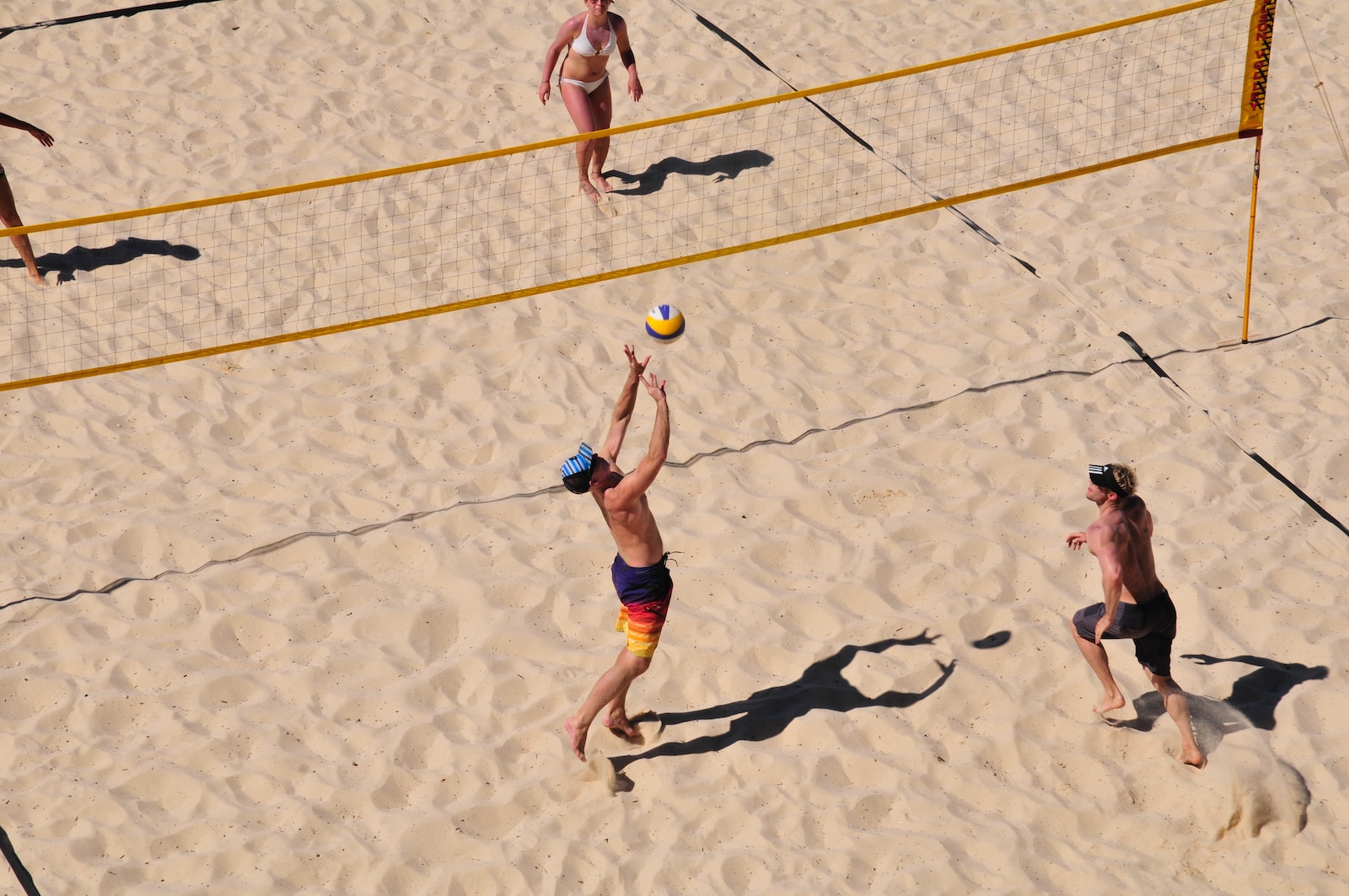Beach volleyball is a popular and exciting sport played on sand, typically on a beach.
One of the unique features of this sport is that it only allows two players per team, unlike indoor volleyball, which has six players per team.
There are several factors that contribute to beach volleyball’s two-player format.
Playing on sand presents a distinct set of challenges that make having fewer players advantageous.
The uneven and soft surface makes movement more difficult and requires greater physical exertion.
With only two players per team, each individual is responsible for covering a larger area of the court.
This not only enhances the athleticism and skill level required for the game but also makes for a more dynamic and engaging spectator sport.
Beach volleyball originated as an informal recreational activity at beaches, where space is often limited.
Having smaller teams allows more people to participate in multiple games simultaneously, thereby promoting the sport’s social and inclusive nature.
The two-player format also facilitates easier organization and logistics, making it more accessible to people of different skill levels and backgrounds.
The two-player format in beach volleyball is an integral aspect of the sport that reflects its unique origins and playing conditions.
It creates a challenging, dynamic, and accessible game that showcases the athleticism, skill, and teamwork of its participants.
History Of Beach Volleyball
The sport of beach volleyball is believed to have originated in 1915 on Waikiki Beach in Hawaii, while the modern two-player version was established in Santa Monica, California.
It was included in the Olympic program starting from the 1996 Summer Olympics.
Fédération Internationale de Volleyball (FIVB) is responsible for organizing the FIVB Beach Volleyball World Championships and the FIVB Beach Volleyball World Tour.
Beach volleyball is played by two teams, each consisting of two or more players, on a sand court separated by a net.
The game aims to send the ball over the net and land it on the opponent’s side of the court. Teams work together to prevent the opposing team from landing the ball on their side of the court.
Important Reasons Why Beach Volleyball Has Only 2 Players
Beach volleyball’s two-player format results from various factors that contribute to the sport’s unique identity and playing conditions.
The main reasons for having only two players per team in beach volleyball are:
Sand Surface
The sand surface of a beach volleyball court adds a layer of difficulty to the game, as moving and jumping on sand requires more effort and energy than on a hard indoor court.
With fewer players, each individual must cover a larger area, increasing the athleticism and skill needed to compete effectively.
Space Constraints
Beach volleyball originated as a recreational beach activity, where space is often limited. Smaller teams allow more games to be played simultaneously, making the sport more accessible and inclusive to a wider range of participants.
Enhanced Teamwork
The two-player format places a greater emphasis on teamwork, communication, and strategic thinking.
Players need to work in tandem and continuously adapt their tactics to outperform their opponents, fostering a strong partnership and higher competitiveness.
Simplified Logistics
Organizing games with smaller teams is logistically easier, enabling more people to participate in the sport.
The two-player format simplifies coordination, making it more attractive for casual players, beachgoers, and local tournaments.
Spectator Appeal
The two-player format contributes to the dynamic and engaging nature of the sport, as it highlights the athletes’ skills, athleticism, and teamwork.
This, in turn, makes it an entertaining and captivating spectator sport.
Is Beach Volleyball More Challenging Compared To Indoor Volleyball?
Playing on an indoor court offers a firm surface, allowing players to jump higher and move more easily compared to the soft, uneven sand of a beach volleyball court.
This difference in terrain can make beach volleyball more challenging, as it demands increased agility, balance, and physical fitness.
Furthermore, indoor volleyball is played in a controlled environment, free from the influence of weather conditions or wind, which can significantly impact gameplay in beach volleyball.
The elements can make the beach volleyball more unpredictable and challenging, requiring players to adapt their strategies and techniques accordingly.
How Does The Sand Surface Impact The Two-Player Format In Beach Volleyball?
The sand surface in beach volleyball presents unique challenges for the players.
The soft and uneven terrain requires increased balance, agility, and physical fitness, making movement and jumping more difficult compared to indoor courts.
The two-player format means each individual must cover a larger area, demanding a higher level of athleticism and skill to compete in the game.
How Did The Two-Player Format Emerge In The History Of Beach Volleyball?
The two-player format in beach volleyball emerged in the 1940s and 1950s as a response to limited space on crowded beaches.
With more people participating in the sport, it became impractical to have larger teams.
The smaller team size allowed for more games to be played simultaneously while also enhancing the athleticism, skill, and teamwork required in the sport.
How Does The 2-Player Format Affect The Strategy And Gameplay Of Beach Volleyball?
The 2-player format in beach volleyball creates a more strategic and tactical game as players must cover the entire court with fewer teammates.
It requires exceptional teamwork, communication, and understanding of each other’s playing styles.
Players must be versatile and perform all roles, including serving, passing, setting, attacking, blocking, and defending.
The limited number of players also results in longer rallies and more spectacular plays, as athletes must cover more ground and make split-second decisions to win points.
How Do The Different Court Dimensions In Beach Volleyball Influence The 2-Player Team Size?
Beach volleyball courts are smaller than indoor volleyball courts, with dimensions of 16×8 meters compared to 18×9 meters, respectively.
This reduction in court size makes it more feasible for only two players to cover the entire area effectively.
The smaller court also creates an intimate, fast-paced game emphasising individual skills, teamwork, and athleticism.
This difference in court dimensions is one of the key factors that led to adopting the 2-player format, which has become a defining characteristic of the sport.

